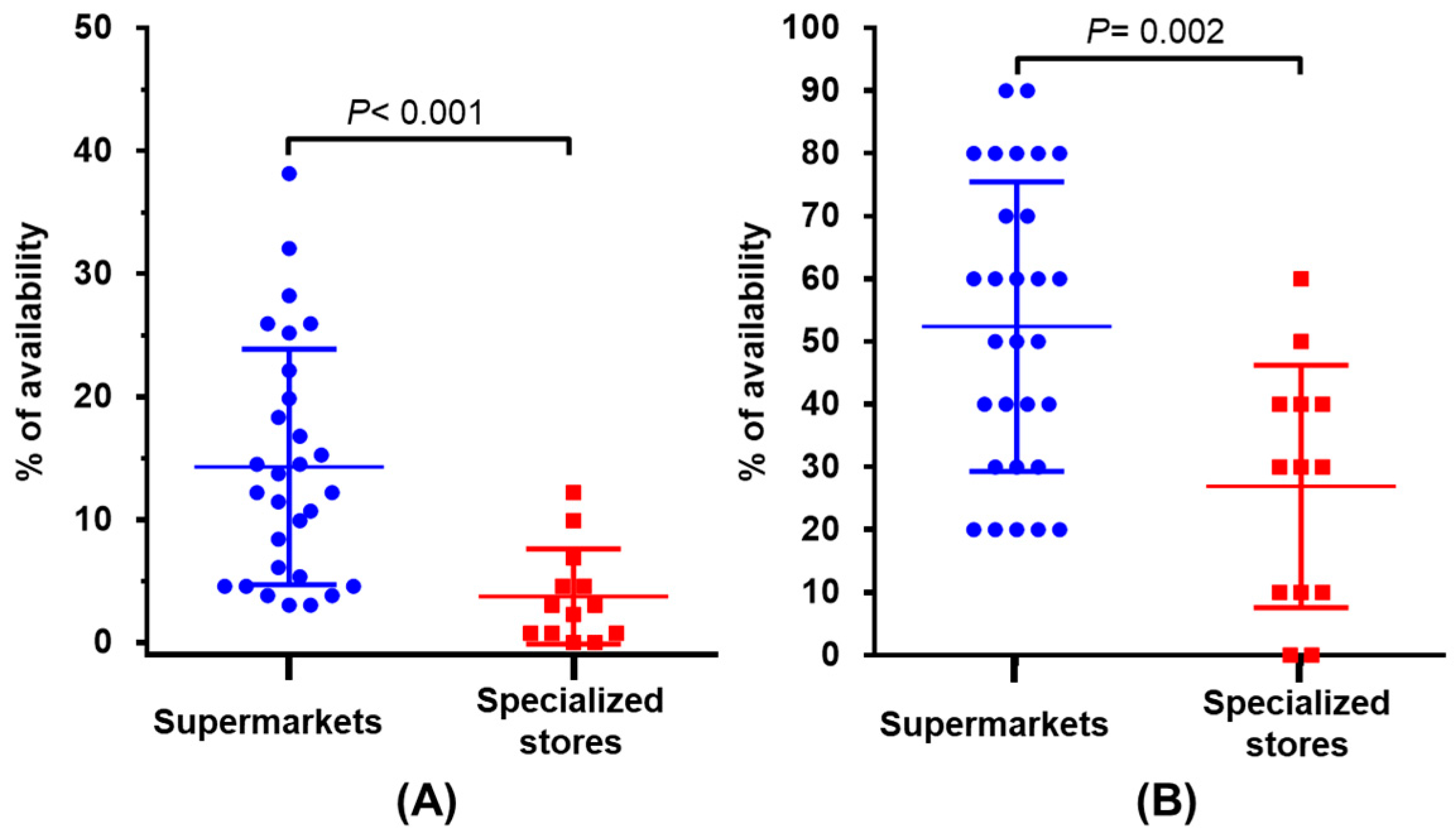Price and Availability of Sugar-Free, Sugar-Reduced and Low Glycemic Index Cereal Products in Northwestern México
Abstract
:1. Introduction
2. Materials and Methods
- ARP: availability rate by product.
- NP: number of different SF, SR, and low GI products available per supermarket or specialized store.
- TP: total of different SF, SR, and low GI products available in Northwestern México (Σ of the different versions of SF, SR, and low GI products available in all the stores visited).
- ARC: availability rate by category.
- NC: number of categories with at least one SF, SR, or low GI food product available in a single store.
- TC: total of food product categories (TC = 10 in this study).
3. Results
3.1. Availability
3.2. Price
4. Discussion
5. Conclusions
Acknowledgments
Author Contributions
Conflicts of Interest
References
- Feinman, R.D.; Pogozelski, W.K.; Astrup, A.; Bernstein, R.K.; Fine, E.J.; Westman, E.C.; Accurso, A.; Frassetto, L.; Gower, B.A.; McFarlane, S.I. Dietary carbohydrate restriction as the first approach in diabetes management: Critical review and evidence base. Nutrition 2015, 31, 1–13. [Google Scholar] [CrossRef] [PubMed]
- Ley, S.H.; Hamdy, O.; Mohan, V.; Hu, F.B. Prevention and management of type 2 diabetes: Dietary components and nutritional strategies. Lancet 2014, 383, 1999–2007. [Google Scholar] [CrossRef]
- Dona, A.C.; Pages, G.; Gilbert, R.G.; Kuchel, P.W. Digestion of starch: In vivo and in vitro kinetic models used to characterise oligosaccharide or glucose release. Carbohyd. Polym. 2010, 80, 599–617. [Google Scholar] [CrossRef]
- Weaver, R.R.; Lemonde, M.; Payman, N.; Goodman, W.M. Health capabilities and diabetes self-management: The impact of economic, social, and cultural resources. Soc. Sci. Med. 2014, 102, 58–68. [Google Scholar] [CrossRef] [PubMed]
- Lee, A.; Ng, D.; Zivin, J.; Green, P. Economic burden of a gluten-free diet. J. Hum. Nutr. Diet. 2007, 20, 423–430. [Google Scholar] [CrossRef] [PubMed]
- Singh, J.; Whelan, K. Limited availability and higher cost of gluten-free foods. J. Hum. Nutr. Diet. 2011, 24, 479–486. [Google Scholar] [CrossRef] [PubMed]
- Burden, M.; Mooney, P.D.; Blanshard, R.J.; White, W.L.; Cambray-Deakin, D.R.; Sanders, D.S. Cost and availability of gluten-free food in the UK: In store and online. Postgrad. Med. J. 2015, 91, 622–626. [Google Scholar] [CrossRef] [PubMed]
- Panagiotou, S.; Kontogianni, M. The economic burden of gluten-free products and gluten-free diet: A cost estimation analysis in greece. J. Hum. Nutr. Diet. 2017. [Google Scholar] [CrossRef] [PubMed]
- Consejo Nacional de Evaluación de la Política de Desarrollo Social. Evolución de las Lineas de Bienestar Y de la Canasta Alimentaria. Available online: http://www.coneval.org.mx/Medicion/MP/Paginas/Lineas-de-bienestar-y-canasta-basica.aspx (accessed on 27 October 2017).
- INEGI. Directorio Estadístico Nacional de Unidades Económicas. Available online: http://www.beta.inegi.org.mx/app/mapa/denue/ (accessed on 27 October 2017).
- Simsek, S.; Ovando-Martínez, M.; Whitney, K.; Bello-Pérez, L.A. Effect of acetylation, oxidation and annealing on physicochemical properties of bean starch. Food Chem. 2012, 134, 1796–1803. [Google Scholar] [CrossRef] [PubMed]
- Hou, C.; Chen, Y.; Chen, W.; Li, W. Microwave-assisted methylation of cassava starch with dimethyl carbonate. Carbohydr. Res. 2011, 346, 1178–1181. [Google Scholar] [CrossRef] [PubMed]
- Hou, C.; Chen, Y.; Li, W. Thiocarbamide and microwave-accelerated green methylation of cassava starch with dimethyl carbonate. Carbohydr. Res. 2012, 355, 87–91. [Google Scholar] [CrossRef] [PubMed]
- Meyer, D. Inulin for product development of low GI products to support weight management. In Dietary Fibre Components and Functions; Wageningen Academic Publishers: Wageningen, The Netherlands, 2007; pp. 257–269. [Google Scholar] [CrossRef]
- Norma Oficial Mexicana NOM-086-SSA1-1994. Bienes y Servicios. Alimentos y Bebidas No Alcohólicas Con Modificaciones en su Composición. Especificaciones Nutrimentales. Available online: http://www.salud.gob.mx/unidades/cdi/nom/086ssa14.html (accessed on 27 October 2017).
- Patton, S.R.; Goggin, K.; Clements, M.A. The cost of a healthier diet for young children with type 1 diabetes mellitus. J. Nutr. Educ. Behav. 2015, 47, 361–366. [Google Scholar] [CrossRef] [PubMed]

| Category of Food | Mean * (SD) (Number of Establishments Contributing Data to the Price) | p | |
|---|---|---|---|
| SF, SR, and low GI | Regular | ||
| Oats | 11.4 (1.8) (21) | 7.3 (2.2) (29) | <0.05 |
| Breakfast Cereal | 14.7 (11.6) (20) | 10.8 (1.7) (28) | 0.151 |
| Cookies and crackers | 20.5 (10.0) (36) | 12.5 (3.9) (29) | <0.05 |
| Granola | 11.3 (2.4) (24) | 10.0 (2.1) (29) | 0.057 |
| Flour | 15.6 (13.04) (14) | 4.7 (1.0) (29) | 0.008 |
| Bread | 10.9 (2.5) (29) | 10.1 (3.9) (27) | 0.334 |
| Pasta | 9.1 (8.7) (19) | 5.9 (3.1) (28) | 0.144 |
| Snack | 35.6 (14.8) (19) | 20.3 (6.0) (29) | <0.05 |
| Tostadas/totopos | 27.5 (11.0) (6) | 7.9 (2.0) (25) | 0.007 |
| Tortilla | 5.0 (0) (1) | 1.45 # | ND ## |
© 2017 by the authors. Licensee MDPI, Basel, Switzerland. This article is an open access article distributed under the terms and conditions of the Creative Commons Attribution (CC BY) license (http://creativecommons.org/licenses/by/4.0/).
Share and Cite
Arámburo-Gálvez, J.G.; Ontiveros, N.; Vergara-Jiménez, M.J.; Magaña-Ordorica, D.; Gracia-Valenzuela, M.H.; Cabrera-Chávez, F. Price and Availability of Sugar-Free, Sugar-Reduced and Low Glycemic Index Cereal Products in Northwestern México. Int. J. Environ. Res. Public Health 2017, 14, 1591. https://doi.org/10.3390/ijerph14121591
Arámburo-Gálvez JG, Ontiveros N, Vergara-Jiménez MJ, Magaña-Ordorica D, Gracia-Valenzuela MH, Cabrera-Chávez F. Price and Availability of Sugar-Free, Sugar-Reduced and Low Glycemic Index Cereal Products in Northwestern México. International Journal of Environmental Research and Public Health. 2017; 14(12):1591. https://doi.org/10.3390/ijerph14121591
Chicago/Turabian StyleArámburo-Gálvez, Jesús G., Noé Ontiveros, Marcela J. Vergara-Jiménez, Dalia Magaña-Ordorica, Martina H. Gracia-Valenzuela, and Francisco Cabrera-Chávez. 2017. "Price and Availability of Sugar-Free, Sugar-Reduced and Low Glycemic Index Cereal Products in Northwestern México" International Journal of Environmental Research and Public Health 14, no. 12: 1591. https://doi.org/10.3390/ijerph14121591






